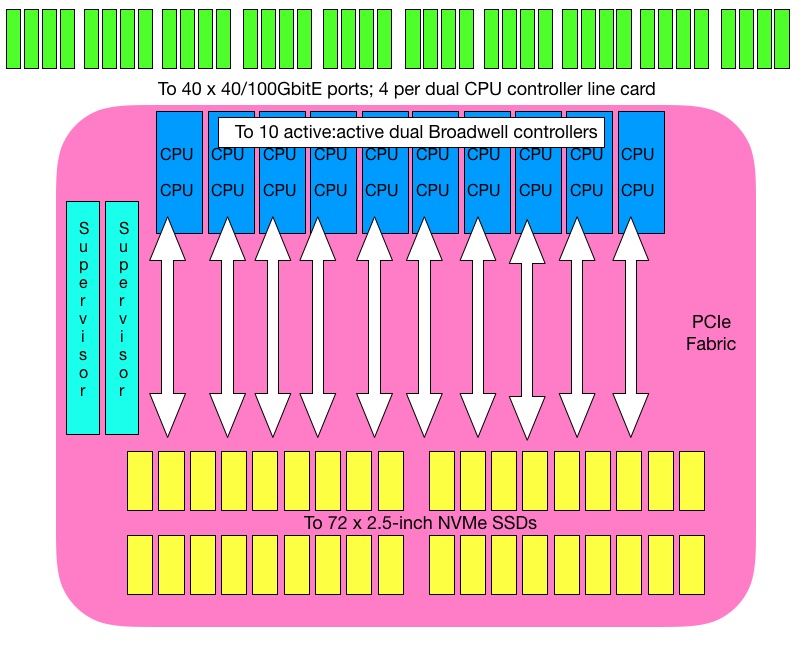NVMe-over Fabrics storage array startup Pavilion Data has crashed.
Update. Co-founder Sundar Kanthadai’s epitaph LinkedIn post added. Jan 1, 2023.
The news was released at an all-hands company meeting on October 10 as Pavilion abruptly withdrew from a scheduled IT Press Tour session this week. It was surprising because Pavilion, led by CEO Dario Zamorian, hired in July 2021, raised $45 million and started looking like it had turned around.

Pavilion’s phone line is being answered by a recorded message directing callers either to leave details or send an email inquiry.
This means the last of the third wave of NVMe-oF all-flash array startups has gone.

Apeiron, E8, Excelero, Mangstor (later Exten), Vexata (bought by StorCentric) and now Pavilion have all crashed, burned, been acquired or otherwise lost their independence. Their dreams of IPO glory are as teardrops in the rain.
Our understanding is that Pavilion didn’t actually run out of cash and it is not bankrupt, but Zamorian and the board tried to sell the company and failed. They had also tried to raise more funding, and that effort failed as well. Clearly Pavilion was going to run out of cash. When that became clear, the investors decided to close the company down. October 12 will be the last day of operation.
We hear that 96 out of 100 employees are being laid off. The severance package is two weeks’ pay in the USA and one month in India. This relatively small amount is because – as the company told its staff – it has no more money in hand.
Pavilion was started up in 2014 with an array technology design based on a network switch with massively parallel design features. The original founders were CEO Kiran Malwankar and VP software engineering (now chief development officer) Sundar Kanthadai. VR Satish joined as CTO in December 2015 from Symantec/Veritas and contributed enough to be classed as a co-founder. Shri Dodani replaced Malwankar as CEO in 2016. Gurpreet Singh replaced him in 2017. Dario Zamorian replaced him in July 2021. He did enough to get another funding round but couldn’t keep up the momentum – the combined effects of COVID, the Russian invasion of Ukraine, supply chain issues, inflation and a looming fear of a recession cut the company’s legs off.
The series of short-lived CEOs was a disaster in its own right.
The initial HyperParallel product had a 4U chassis with up 20 controllers talking to 72 SSDs across a PCIe fabric, with host access by RoCE and NVMe/TCP. Its performance was remarkable at the time: average read latency of 117μs, up to 120GB/sec read bandwidth, 60GB/sec write bandwidth and 20 million 4K Random Read IOPS.

The company had some 20 to 30 customers in 2017, concentrated in the US federal sector, not many channel partners, and a generous but then parsimonious funding history.
- 2016 and 2017 – 2-part A-round raising $21 million
- 2018 – B-round for $11 million
- 2019 – C-round for $25 million
- 2020 – nothing
- 2021 – nothing
- 2022 – $45 million
The total raised this way was was $103 million. Qumulo, another hardware/software storage startup, raised $351 million – more than three times as much.
The fundamental problem was that the mainstream incumbents – Dell, DDN, Hitachi Vantara, HPE, IBM, NetApp and then Pure Storage – developed NVMe-oF systems themselves and effectively rendered their customer bases impervious to the appeal of the NVMe-oF startups like Pavilion. Even if Pavilion had been given more funding, it may well not have succeeded. It might have become a Pure mark 2.
So that’s it, end of story – unless there is an epilog provided by a sale of the assets. Say farewell to Pavilion, sigh with regret, and move on.
Bootnote
On Jan 1, 2023 Kanthadai posted a note on LinkedIn which said: “As you all know, Pavilion has ceased operations due to the economic headwinds of 2022.”
He said in this epitaph post: “We had a great run for 8+ years where we had some massive wins at large enterprises and federal accounts. We pioneered the NVMeOF technology deployments at scale (thousands of servers in the cluster) and showed that NVMe over RoCE can comfortably be deployed in traditional enterprise (L2/L3) environments. We built our hyper-parallel filesystem on top of our block, and broke various performance records with NVIDIA‘s MagnumIO. We worked with various high profile customers and tackled their low latency & high bandwidth use cases, other vendors were afraid to go after. We brought low latency IO to all performance hungry applications including the ones that run on Windows, irrespective of their storage protocols. Lot to be proud of, during our short stint.”
What’s next for him? “I have accepted a position in an adjacent and exciting space which is near/dear to my interests…data management and security. I will update my profile after the new year.”
The post attracted a slew of appreciative comments.








